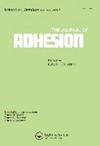The dependence of rubber tackiness on separation speed
IF 2.3
4区 材料科学
Q2 ENGINEERING, CHEMICAL
引用次数: 0
Abstract
ABSTRACT In the present work, the tack properties of a number of uncrosslinked polymers, oil-extended rubbers and particle-filled elastomers to a metal surface were investigated by first contacting a cylindrical metal probe with a flat-ended surface with an elastomer surface and then detaching the probe from the adhered substrate at various separation speeds. Our results reveal that there are simple and universal laws governing the tackiness behavior of these materials. Specifically, when the pulling speed (Vs ) is greater than a critical speed (Vc ), the maximum tack force (Fmax ) can be generally described by the following scaling relationships: Fma x ~ Vs 1/3 and Fmax ~ tmax −1/2, where tmax is the time when the maximum force is reached in the force-time profile. The chemical composition, polymer structure, plasticizer type and filler type in a rubber compound can affect the magnitude of the tacky force at a given separation speed, but have little or no effect on these scaling relationships that primarily exist at high separation speeds.橡胶粘性对分离速度的依赖性
摘要在本工作中,通过首先将具有平端面的圆柱形金属探针与弹性体表面接触,然后以不同的分离速度将探针从粘附的基底上分离,研究了许多未交联聚合物、充油橡胶和颗粒填充弹性体对金属表面的粘附性能。我们的结果表明,这些材料的粘性行为存在简单而普遍的规律。具体而言,当牵引速度(Vs)大于临界速度(Vc)时,最大粘着力(Fmax)通常可以用以下比例关系来描述:Fma x~Vs 1/3和Fmax~tmax−1/2,其中tmax是力-时间曲线中达到最大力的时间。橡胶化合物中的化学组成、聚合物结构、增塑剂类型和填料类型可以在给定的分离速度下影响粘着力的大小,但对这些主要存在于高分离速度下的结垢关系几乎没有影响。
本文章由计算机程序翻译,如有差异,请以英文原文为准。
求助全文
约1分钟内获得全文
求助全文
来源期刊

Journal of Adhesion
工程技术-材料科学:综合
CiteScore
5.30
自引率
9.10%
发文量
55
审稿时长
1 months
期刊介绍:
The Journal of Adhesion is dedicated to perpetuating understanding of the phenomenon of adhesion and its practical applications. The art of adhesion is maturing into a science that requires a broad, coordinated interdisciplinary effort to help illuminate its complex nature and numerous manifestations.
 求助内容:
求助内容: 应助结果提醒方式:
应助结果提醒方式:


